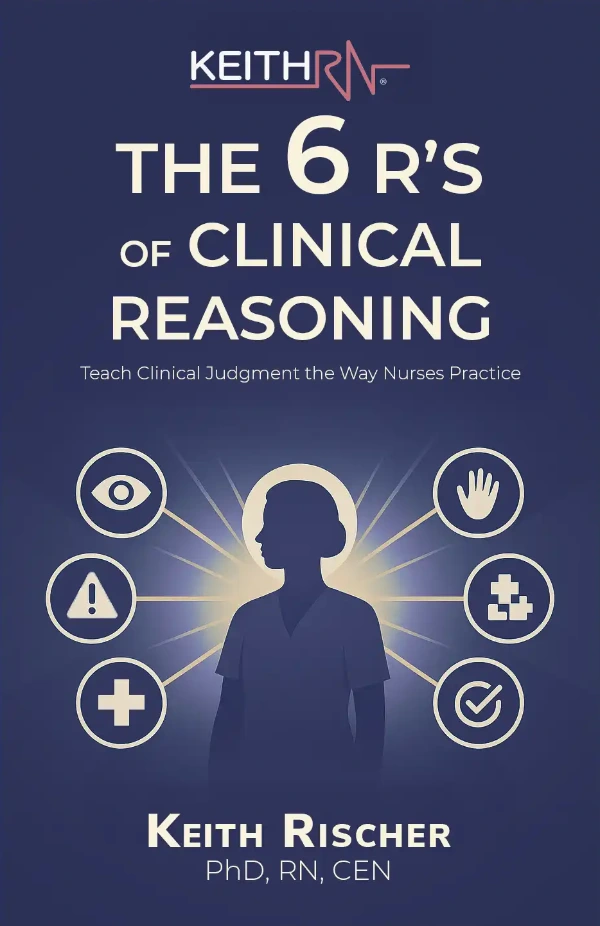
This post was written by Lisa Gonzalez, MSN, RN.
The beginning of a new year brings a mindset that welcomes a fresh start. New opportunities and challenges await us. For the nurse educator, 2023 is a much-anticipated year with the launch of the Next Generation NCLEX. But finding and implementing strategies that prepare our students to practice sound clinical judgment may feel overwhelming.
A new year’s resolution can set the tone for the year, but most resolutions flop or are short-lived. Resolutions can fail when they are unrealistic, yet a small change carries the potential for significant impact.
A fellow caregiver, Mother Teresa, once said, “I alone cannot change the world, but I can cast a stone across the waters to create many ripples.”
Developing Clinical Judgment
What small change can you integrate into your teaching practices that may improve your students’ clinical judgment, preparing them for practice and the Next Generation NCLEX? One idea can create ripples in your classroom, nursing program, or curriculum, bringing benefits to your students and colleagues.
A challenge, perhaps; however, this could also be an opportunity for growth, questioning the status quo, and trying something new. We can’t simply do what we have always done and expect change.
So, why not begin this year with a nurse educator’s new year’s resolution? One with a focus on teaching to develop students’ clinical judgment.
Defining Terms
Making a dent in students’ clinical judgment development begins with nurturing our knowledge base. Clinical judgment, clinical reasoning, the nursing process, and critical thinking have been used interchangeably. While these terms are related, they each hold distinct meanings.
In Teaching Clinical Reasoning, a recent YouTube video that every educator needs to watch, Dr. Patricia Benner addressed this point and used the metaphor of seeing the nursing process as a linear problem-solving snapshot a nurse uses, for example, at the beginning of the clinical day. The nurse then uses the thinking-in-action skill of clinical reasoning as a motion picture the nurse uses throughout the day to determine concerning trends and new priorities.
To develop critical thinking, students must understand essential content so it can be applied. This knowledge acquisition takes place primarily in the classroom. Clinical reasoning is the reasoned application of knowledge that intersects with the nursing process and the clinical reasoning processes of noticing, interpreting, responding, and evaluative reflecting identified in Tanner’s Clinical Judgment Model. Clinical judgment is an outcome that requires the nurse to critically think and clinically reason.
Ensuring that we understand the difference between the terms facilitates how we approach teaching to develop the clinical reasoning and critical thinking skills necessary to make clinical judgments. When we have created a mental picture of how the separate terms fit together, we can explain these differences to our students and tailor our teaching strategies with an emphasis on clinical reasoning and clinical judgment.
Teaching Clinical Judgment
Teaching for clinical judgment development involves intentional approaches that develop clinical reasoning skills. For example, clinical reasoning begins with noticing, which requires observation skills. Students must learn astute observation skills if they are to gather relevant data.
Furthermore, the gathered information must be correctly interpreted and analyzed to arrive at appropriate conclusions about patient care situations. Noticing, interpreting, responding, and reflecting are all involved in making clinical judgments.
Once your students become more familiar with clinical reasoning skills, they will become aware of the cognitive work involved in determining the most appropriate interventions. If they did not correctly interpret or analyze the situation, they may very well choose the wrong action.
Be sure to use a practice-informed framework to teach clinical judgment, and the reasoning steps a nurse uses in practice, including the nursing process and Tanner’s Clinical Judgment Model (2006). Be as familiar with the clinical reasoning steps of noticing, interpreting, responding, and reflecting that Tanner identified as you are with the steps of the nursing process!
My Journey
My passion for teaching clinical reasoning was incited when I was a new nurse educator and has further developed over the last several years. I taught clinical at a nursing program that used the nursing process. While the nursing process provides a standard approach to patient care, I noticed that students struggled to understand the thinking behind nursing actions. Their care plans were scattered, their nursing diagnosis was not well supported with relevant focused data, and their interventions did not demonstrate priority responses.
Fast forward to completing my master’s in nursing education and taking a full-time position in a new nursing program. I quickly noticed the same struggles, but was armed with knowledge to take action. Our nursing program integrates the nursing process throughout the nursing curriculum, yet we did not approach teaching to develop clinical judgment as carefully as we teach the steps of the nursing process.
In addition, I soon discovered that our clinical evaluation tool (CET) is an adaptation of the Lasater Clinical Judgment Rubric (LCJR), grounded in Tanner’s Clinical Judgment Model. Using the CET, we evaluate students’ clinical judgment, but I still noticed students struggling to understand the thinking behind nursing actions. Now here is an opportunity!
How do nurses complete focused observations and why? I decided to create a structured approach to teaching and learning the same clinical reasoning skills we evaluate via the CET. I also wanted to help students connect what they learned with the realities of nursing practice.
So I developed the clinical reasoning clinical education curriculum using a concept-based approach to help students connect nurse thinking (clinical reasoning) with their decisions and actions (clinical judgments). We break down clinical reasoning skills during clinical by exploring one clinical reasoning concept each week.
We explore clinical reasoning skills through weekly lessons, learning activities, and guided discussions that unpack clinical reasoning step by step, piece by piece. The concepts are adapted from Tanner’s Clinical Judgment Model and Lasater’s Clinical Judgment Rubric (LCJR). I’ve been doing this for the last seven years and have noted improvement!
Next Steps
What is one small action that you can commit to this year? Nurse educators, this is the year to institute change! Perhaps this is the year to spend much-needed time nurturing your knowledge base. Maybe you can try out a teaching strategy with an emphasis on developing clinical judgment. Whether you implement this teaching strategy in the classroom, laboratory, or clinical offers the potential to strengthen your students’ clinical judgment.
One webinar, article, or conversation with a colleague may bring valuable ideas or information you can integrate into your teaching practices. Finally, your momentum can spread to others. Be brave and willing to share your knowledge with others. Prepare a few talking points to present at the next nursing program meeting. Create a vlog or share your experience through an educational innovation brief or publication.
In Closing
We have challenges and opportunities as we count down to the Next Generation NCLEX. Our challenge is an opportunity to determine and commit to one small action that ripples effects on our students, colleagues, nursing program, and nursing education.
Let’s commit to needed change by putting first things first as our nurse educator’s new year’s resolution! As we teach our students to use clinical reasoning that supports clinical judgment, we prepare them not just for the NCLEX, but also to be effective practicing nurses who represent the future of the nursing profession.
Recommended Resources
To get you started on your journey to transforming the way you teach to develop clinical judgment, here are a few resources to get you started:
- Article: Thinking Like a Nurse: A Research-Based Model of Clinical Judgment in Nursing. Tanner (2006)
- Article: Teaching Clinical Reasoning Piece by Piece. Gonzalez (2018)
- Article: Developing Student’s Clinical Reasoning: A Faculty Guide. Gonzalez, Nielsen, Lasater (2021)
References
Ashley, J. & Stamp, K. (2014). Learning to thinking like a nurse: The development of clinical judgment in nursing students. Journal of Nursing Education, 53(9). 519-525.
Fedko, A., & Dreifuerst, K. (2017). Examining the relationship between clinical judgment and nursing actions in prelicensure students. Nurse Educator, 42 (1), 47-50.
Gonzalez, L. (2018). Teaching clinical reasoning piece by piece: A clinical reasoning concept-based learning method. Journal of Nursing Education, 57(12), 727-735.
Gonzalez, L., Nielsen, A., Lasater, K. (2021). Developing students’ clinical reasoning skills: A faculty guide. Journal of Nursing Education, 60(9), 485-493.
Holder A. G. (2018). Clinical reasoning: A state of the science report. International Journal of
Nursing Education Scholarship, 15(1), 1-10.
Joplin-Gonzales, P., & Rounds, L. (2022). The essential elements of the clinical reasoning process.
Nurse Educator. 47 (6), E145-E149.
Klenke-Borgmann, L., Cantrell, M, Mariani, B. (2020). Nurse educators’ guide to clinical judgment: A
review of the conceptualization, measurement, and development. Nursing Education Perspectives, 41(4), 215-221
Lasater, K. (2007). Clinical judgment development: Using simulation to create an assessment rubric.
Journal of Nursing Education, 46(11), 496-503.
Manetti, W. (2019). Sound clinical judgment in nursing: A concept analysis. Nursing Forum, 54(1): 102-
110.
Nielsen, A. (2016). Concept-based learning in clinical experiences: Bringing theory to clinical education
for deep learning. Journal of Nursing Education, 55(7), 365–371.
Tanner, C. (2006). Thinking like a nurse: A research-based model of clinical judgment.
Journal of Nursing Education, 45(6), 204-211.
Victor-Chmil, J. (2013). Critical thinking versus clinical reasoning, versus clinical judgment:
Differential diagnosis. Nurse Educator, 38(1), 34-36
Lisa Gonzalez, MSN, RN, is currently pursuing her PhD in Nursing Education at the University of Northern Colorado. Lisa is a professor at the College of Southern Maryland, teaching students in both adult medical-surgical theory and clinical courses. She is passionate about developing students’ clinical reasoning skills in the clinical setting and developed a concept-based approach and was the author of Teaching Clinical Reasoning Piece by Piece: A Clinical Reasoning Concept-Based Learning Method which was published in the Journal of Nursing Education in 2018. She collaborates with nursing education leaders to strengthen and integrate clinical reasoning into the nursing curriculum using practical and evidence-based approaches.
The Ultimate Solution to Develop Clinical Judgment Skills
KeithRN’s Think Like a Nurse Membership
Access exclusive active learning resources for faculty and students, including KeithRN Case Studies, making it your go-to resource.




